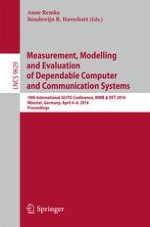2016 | Buch | 1. Auflage
Measurement, Modelling and Evaluation of Dependable Computer and Communication Systems
18th International GI/ITG Conference, MMB & DFT 2016, Münster, Germany, April 4–6, 2016, Proceedings
herausgegeben von: Anne Remke, Boudewijn R. Haverkort
Verlag: Springer International Publishing
Buchreihe : Lecture Notes in Computer Science
